C.J. Adrien's Blog, page 2
August 25, 2025
Le Commencement Ambigu : le raid de 799 sur Noirmoutier
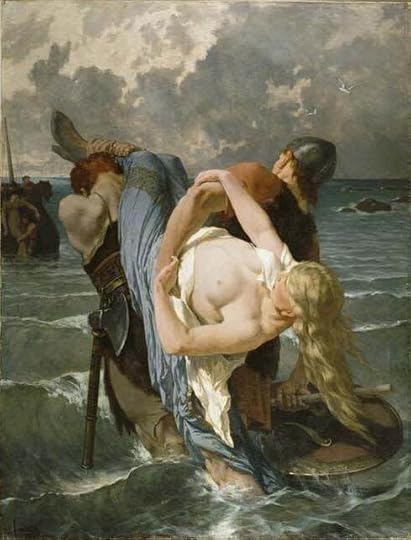 Pirates normands au IXᵉ siècle, huile sur toile, par Évariste-Vital Luminais (1821–1896), Musée Anne de Beaujeu à Moulins.
Pirates normands au IXᵉ siècle, huile sur toile, par Évariste-Vital Luminais (1821–1896), Musée Anne de Beaujeu à Moulins.Le week-end dernier, au Salon du Livre de L’Épine, ici même sur l’île de Noirmoutier, j’ai rencontré des dizaines de lecteurs curieux, vendu un bon nombre de livres et eu des conversations inoubliables. Ce qui m’a le plus frappé, c’est combien peu de personnes, même sur l’île, connaissaient la place de Noirmoutier dans l’histoire viking. Pour la plupart, Lindisfarne en 793 est le fameux « premier » raid. Bien moins nombreux sont ceux qui ont entendu parler de l’attaque du monastère de Saint-Philibert en 799, que de nombreux historiens considèrent comme le début de deux siècles d’activité viking en France de l’Ouest.
Cela m’a donné une idée : et si je racontais cette histoire correctement, non pas en un seul long article, mais sous la forme d’une enquête approfondie et suivie ? Ainsi, pour le reste de l’année, je vais vous emmener semaine après semaine à travers chaque événement significatif des invasions vikings en France de l’Ouest : des raids aux batailles, des intrigues politiques aux débats entre historiens, en passant par mes propres réflexions sur ce que les sources laissent entrevoir.
Aujourd’hui, nous commençons tout au début — ou peut-être un début — avec une attaque qui, selon certains, n’aurait même pas été un raid viking.
Le récit traditionnel du raid de 799 sur NoirmoutierLa plupart des livres d’histoire modernes affirment qu’en 799, des Vikings attaquèrent le monastère de Saint-Philibert sur l’île de Noirmoutier. On le présente généralement comme un fait établi. La position de l’île à l’embouchure de la Loire en faisait une base avancée idéale pour les flottes scandinaves. Son monastère, comme celui de Lindisfarne six ans plus tôt, était riche, peu défendu et facilement accessible par mer.
Le cœur de cette tradition vient d’une lettre du théologien Alcuin d’York, célèbre pour avoir décrit les horreurs de Lindisfarne. Écrivant à l’évêque Arno de Salzbourg, Alcuin rapporte une attaque de paganae (« païens ») contre les îles d’Aquitaine. La formulation reste vague : aucun monastère n’est nommé, et « païens » pouvait désigner plusieurs groupes. Mais les historiens ont traditionnellement rattaché cette lettre aux récits carolingiens ultérieurs qui mentionnent une activité viking le long de la côte aquitaine.
Deux biographes impériaux du début du IXᵉ siècle renforcent cette interprétation. Rimbert, dans Les Deux Vies de Charlemagne, raconte qu’autour de l’an 800, l’empereur rencontra une flotte viking au large de l’Aquitaine ; lorsqu’ils apprirent que Charlemagne lui-même était présent, ils s’enfuirent. Einhard, dans sa Vita Karoli Magni, situe également Charlemagne en Aquitaine à cette époque et note que la région était « infestée par les Northmen » (Nordmannicis infestum erat).
Des sources ultérieures précisent encore le récit. Une lettre de l’abbé de Saint-Philibert en 819 se plaint de raids fréquents, ce qui suggère un phénomène remontant à plusieurs années. Dans les années 830, le moine Ermentaire évoque une première attaque, sans en donner beaucoup de détails. En combinant ces témoignages, l’historiographie traditionnelle s’impose : les Vikings auraient frappé Saint-Philibert en 799, ouvrant une longue période de raids sur l’île.
La remise en question du raid de 799 sur NoirmoutierL’historien Simon Coupland a été l’un des premiers à contester publiquement ce récit. Ses principaux arguments sont les suivants :
Ermentaire mentionne aussi une tentative de raid maure dans la région, preuve que des flottes musulmanes d’al-Andalus étaient actives sur la côte ouest de la France à cette époque.
Alcuin employait parfois le terme paganae pour désigner les musulmans autant que les Vikings. Ainsi, quand il rapporte que des païens ont attaqué des « îles d’Aquitaine », il ne visait peut-être pas des Scandinaves.
Sans mention directe de « Northmen » ou de « Danois », attribuer l’attaque de 799 aux Vikings peut être anachronique, d’autant que les raids vikings indubitables dans la région apparaissent surtout 10 à 15 ans plus tard.
La mise en garde de Coupland est méthodologique : les historiens ne devraient pas assimiler chaque raid côtier du début du IXᵉ siècle à une attaque viking simplement parce que les sources ultérieures mettent en avant les Scandinaves.
Pourquoi je pense malgré tout qu’il s’agissait bien de VikingsIl est vrai, comme le souligne Coupland, que les preuves pour 799 sont minces. Mais mince ne veut pas dire inexistante. Et à mes yeux, ce que nous avons vu correspond davantage à un raid viking qu’à une attaque maure. L’expression d’Alcuin « îles d’Aquitaine » s’accorde parfaitement avec Noirmoutier, l’Île d’Yeu et l’Île de Ré, comparables aux îles-relais déjà utilisées par les Scandinaves ailleurs, comme en Irlande ou dans les Hébrides. La chronologie aussi fait sens : après Lindisfarne (793) et Iona (795), progresser vers l’ouest et le sud en direction de la Loire, avec son accès à l’intérieur franc (et son sel !), aurait été une suite naturelle.
Les sources impériales renforcent cette idée. Rimbert et Einhard décrivent tous deux Charlemagne confronté à des « Northmen » en Aquitaine, difficile à concilier avec une simple attaque maure. Si seuls des musulmans avaient menacé la côte, pourquoi ces biographies indépendantes insisteraient-elles tant sur la menace scandinave ? Les intérêts d’Alcuin vont dans le même sens : il a beaucoup écrit sur les dangers que posaient les Norse à la chrétienté et aurait été prompt à relater un de leurs raids, bien plus qu’une incursion maure hors de sa sphère immédiate.
D’autres indices viennent de la réaction militaire immédiate de Charlemagne. Les Capitularia missorum specialiarapportent qu’il ordonna « de navigia praeparando circa littoralia maris » (« de préparer des navires sur les côtes maritimes »), « de navibus quas facere iussimus » (« sur les navires que nous avons ordonné de construire »), et « de materia ad naves faciendas » (« sur les matériaux nécessaires à la construction des navires »). L’Astronome note de même que Charlemagne « avait donné ordre alors de faire construire des navires contre les incursions des Northmen sur tous les fleuves se jetant dans la mer », et qu’il confia cette tâche à son fils sur la Garonne et la Loire. Ces mesures, datées par certains vers l’an 800, suivent de si près les événements de 799 qu’elles apparaissent presque comme une reconnaissance explicite de la menace viking. Elles auraient peu de sens si le raid avait été d’origine maure.
Enfin, la continuité joue un rôle. Dès 819, les moines de Saint-Philibert se plaignent d’attaques « fréquentes ». Ce schéma s’explique mieux si le phénomène avait commencé dès 799, plutôt que d’apparaître ex nihilo une décennie plus tard.
Aucun historien ne peut prétendre à une certitude absolue. Mais quand la géographie, la chronologie et les témoignages convergent dans la même direction, le poids des preuves penche, selon moi, vers une attaque viking plutôt que maure.
Pourquoi cet événement est importantÀ première vue, savoir si les assaillants de 799 étaient des Vikings ou des Maures peut sembler un détail. Mais dans une perspective plus large, cela modifie notre compréhension de la rapidité avec laquelle les Scandinaves passèrent des îles britanniques au monde franc, et de la vitesse à laquelle Charlemagne les identifia comme une menace stratégique.
Si 799 en marque le début, alors la pression viking sur l’empire commença du vivant de Charlemagne, et non après sa mort. Cela reconfigure l’interprétation de ses politiques côtières, de ses défenses fluviales et de son effort naval au début du IXᵉ siècle. Cela place aussi Noirmoutier directement au cœur du premier affrontement entre Carolingiens et Vikings, et non dans une vague secondaire.
Cela rejoint enfin mes recherches sur ce que j’appelle l’« Hypothèse du Sel » : l’idée que les premiers raids vikings en France de l’Ouest furent motivés en partie par le besoin de sel pour conserver le hareng destiné au commerce avec l’Est. Avec ses marais salants, Noirmoutier aurait représenté une cible de choix pour des Scandinaves cherchant à s’assurer cette ressource. Si le raid de 799 fut bien viking, alors il ne marque pas seulement le début de leur présence militaire, mais aussi le premier coup d’une campagne stratégique visant à contrôler l’une des denrées les plus précieuses du haut Moyen Âge.
La semaine prochaine : le raid de Bouin en 820Si 799 fut le premier coup, ce ne fut pas le dernier. En 820, une flotte viking tenta de remonter la Seine, fut repoussée, et se tourna vers l’île de Bouin, moins bien défendue. Ils repartirent avec un « butin immense ». Cet épisode nous offre un regard encore plus clair sur les tactiques vikings des premières années de leurs raids en France de l’Ouest.
Nous explorerons ce récit la semaine prochaine : les sources, les implications stratégiques et comment des attaques comme celle de Bouin préparèrent le terrain à l’installation permanente des Scandinaves à Nantes plus tard dans le siècle.
Si cette série vous intéresse, vous pouvez vous abonner pour recevoir chaque épisode directement dans votre boîte mail. À la fin de l’année, vous disposerez d’un guide chronologique complet des invasions vikings en France de l’Ouest, de Noirmoutier à la chute de Nantes, et au-delà.
And, as always…Buy my novels!
Pépin’s 826 Toll Exemption and What It May Tell Us About Viking Activity During a “Quiet” Decade.
 A coin of Pépin I of Aquitaine.
A coin of Pépin I of Aquitaine.Last week, we looked at the Viking attack on the island of Bouin in 820 within the context of the 819 charter to move the monastery of Saint Philbert to Déas during raiding season. After that, the record thins. The Annals of Saint-Bertin do not begin until the 830s, so the Loire coast in the 820s sits in a quiet patch. That’s where one surviving charter picks up the thread.
On 18 May 826, at Pierrefitte, Pépin I of Aquitaine confirmed an earlier precept of Louis the Pious and granted Saint-Philibert six boats free of tolls across his rivers. It reads like policy aimed at keeping a stressed economy moving. The monastery of Saint Philbert had split its life between Herio (Noirmoutier) offshore and Déas on the mainland near Grand Lieu Lake, and boats tied that system together.
The document is plain about scope and purpose:
“…immunes ab omni teloneo … per alveum Ligeris, Helerium, Carim … per caetera diversa flumina ob necessitates ipsius monasterii fulciendas.”
“free from every toll … on the Loire, the Allier, the Cher … and on other rivers to support the needs of the monastery.”
It also bans named exactions “in the common tongue,” the small bites that stack up on every landing:
“Nullus … teloneum, quod vulgari sermone dicitur ripaticum aut portaticum aut salutaticum … aut coenaticum … audeat.”
“No one may dare exact any toll called river-toll, port-toll, greeting-toll … or lodging-toll …”
And it sets the operating rule with the river list:
“cum eisdem sex navibus libere ire et redire sive per Ligerem, Helarium, Carim, Dordoniam, Garonnam…”
“with those same six ships free to go and return on the Loire, Allier, Cher, Dordogne, Garonne …”
Trade is allowed when needed:
“Quod si mercandi vel vendendi gratiam … facient, … nihil … ab eis exigi praesumatur.”
“If they need to buy or sell, they may do so, and nothing is to be demanded from them.”
What does this document tell us? The island’s economic output mattered to Pepin. Letting Saint Philibert fail would have choked off the goods and revenue he relied on. He stepped in to rescue the house so its value to him would not collapse. The aim is stated in the text—“to support the needs of the monastery.” Needs, not luxuries.
Here is where the narrative gap forces us to reason from context. We have 820 (Bouin) as a shock event. We have 819 as institutional adaptation in the move to Déas because of “frequent incursions.” Then we have 826 as fiscal relief. The charter never says “raids” or “salt.” It does not list cargoes, nor does it show a ledger. Yet the policy fits a house trying to keep supply lines working in a decade when violence and petty dues made movement fragile. Certain historians, whose works focus on the pilgrimages of the monks of Saint Philbert during the Viking Age, have pointed to the charter as telling. The picture that emerges is an organization under strain, either due to prior and/or continuing economic disruption from Viking raids.
There are other readings worth keeping in view. Rulers granted toll relief for reasons that were not always tied to a crisis. For example, they sometimes granted favor to an abbey for helping them with a spiritual problem, or to atone for something bad that they did, or simply piety dressed as policy. Some of the terms in the toll list vary across copies. River names show minor spelling shifts in different editions. We should admit the seams.
Even with that caution, the shape holds. If you strip away the narrative silence of the 820s, you see a line of practical measures: move inland for safety, protect the boats that move goods, and cut the fees that make each trip cost more than it yields. In short, 826 is a tool to keep cash flow and provisioning from stalling while the coast remained unstable.
Where the annals pick up in the 830s, we see that this lull is likely in pen only, and that the waters off the coast of Brittany and Aquitaine were infested with Odin’s sharks. That’s where we will pick up next week: with the unfolding drama of repeated incursions on the island of Noirmoutier and the exceptional move by Pepin to grant them a charter to build a castrum to defend themselves.
If you can’t wait until next week to hear about it, live it in my first novel, The Lords of the Wind, which culminated in the epic battle on the island of Noirmoutier between a Frankish army and the most notorious Viking warlord of them all, Hasting.
And, as always…Buy my novels!
August 18, 2025
Vikings at Bouin: France’s Second Earliest Raid (Allegedly).
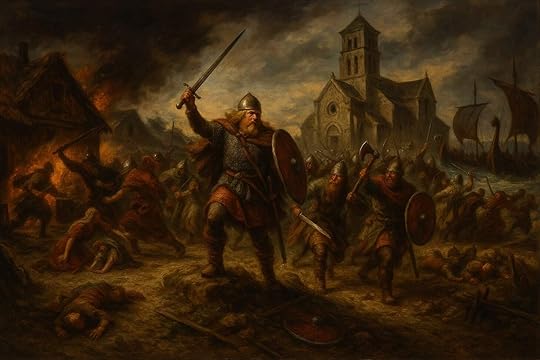 The Viking Raid on Bouin, 820, in the style of Peter Nicolai Arbo. Image by Dall-E.
The Viking Raid on Bouin, 820, in the style of Peter Nicolai Arbo. Image by Dall-E.Last week, I wrote about the alleged Viking raid on Noirmoutier in 799, an event debated by scholars but central to understanding the beginnings of Scandinavian pressure on the Frankish Empire. This week, we turn to another early raid: the attack on Bouin. The sources disagree on when exactly this occurred—some say 813, others 820—but either way, the event sheds light on the early presence of Vikings in Aquitaine. Along with other scattered evidence, it suggests that Scandinavians may have been more active on the Atlantic coast during the reigns of Charlemagne and Louis the Pious than the scant surviving records let on.
An Island No MoreDrive today from Nantes toward Noirmoutier and you’ll pass through broad, reclaimed country, flat fields punctuated by salt pans and marsh birds. A road cuts straight across to the island of Noirmoutier, famous for its beaches, salt, and potatoes. But along the way, you pass through Bouin, a quiet town that looks landlocked. It is hard to imagine that, in the early ninth century, Bouin was surrounded by the sea and that it was one of the first communities in France to feel the sting of Viking raiders.
In the ninth century, Bouin sat in the Bay of Bourgneuf, a low-lying island facing Noirmoutier. The two were part of a maritime landscape dominated by tidal channels, marshes, and salt production. For Scandinavian raiders probing the Frankish coast, Bouin and Noirmoutier were tempting targets: wealthy, accessible by ship, and poorly defended.
That geography has since changed. From the seventeenth century onward, Dutch engineers reclaimed marshland in the Marais breton-vendéen, building dikes and polders that linked the islands to the mainland. Today, Bouin is no longer an island at all, but a small town on the road to Noirmoutier. In the Viking Age, though, it was ringed by water, its salt pans and stores of fish and livestock an inviting prospect for men in longships.
813 or 820?So when did the Vikings strike Bouin? Here, the sources diverge. Some secondary accounts give 813, but the secure evidence is for 820.
The Royal Frankish Annals (Annales Einhardi), written close to the events, record that in 820 a Viking flotilla, after unsuccessful raids in Flanders and at the mouth of the Seine, turned south to Aquitaine. There, they “completely devastated a vicus called Bundium [Bouin] and returned home with immense booty.”
But even if the attack we can name and date happened in 820, the evidence suggests Bouin and its neighbors were harassed long before.
“Because of the Frequent Incursions”One year earlier, in 819, Emperor Louis the Pious issued a royal diploma for Abbot Arnulf of Noirmoutier. It authorized the foundation of a satellite monastery at Déas (today Saint-Philibert-de-Grand-Lieu), further inland. The reason was explicit: it was needed “because of the incursions of the barbarians who frequently ravage the monastery at Noirmoutier.”
This is not a monk’s lament written years later; it is a hard administrative document (Ah, l’administration Française!). Even before the 820 annalistic entry, the monks of Saint-Philibert were under sustained pressure and had to move their community inland to survive. The Bouin raid of 820, then, is not an isolated incident but part of a pattern of harassment in the Loire estuary.
Charlemagne and the NorthmenEvidence for this pressure reaches even earlier. Einhard, Charlemagne’s courtier and biographer, writes in his Life of Charlemagne that the emperor had organized coastal defenses against the Northmen, just as he had against Muslim raiders in the south. While Einhard gives little detail, it shows that the threat from the sea was recognized during Charlemagne’s reign.
The most famous anecdote, however, comes from Notker the Stammerer, writing later in the ninth century. He tells of Charlemagne at a villa on the coast of Narbonnesian Gaul when word came that Northmen had been sighted offshore. The emperor rose from the table, looked out the window, and saw the ships fleeing “with marvellously rapid flight.” The Franks could not catch them—their boats were too fast. Charlemagne wept, saying he was “sick at heart,” not out of fear for himself, but because he foresaw the destruction these enemies would visit upon his descendants.
Notker’s account, considered fictitious by most historians, is colored by hindsight and moral lesson, but the vignette captures something essential: there was already a memory of Viking ships on the Aquitanian coast in Charlemagne’s time, and even the great emperor could do little to stop them.
Why Bouin? The Salt HypothesisWhy would Vikings keep probing these particular islands? One answer lies in geography and trade.
Both Noirmoutier and Bouin were salt-producing islands. Salt was the essential preservative of the medieval world, and it may have had growing importance in the early ninth century as Baltic herring fishing expanded. Scandinavian traders, according to my theory, may have needed vast quantities of salt to cure fish for export to eastern markets. If we take the 819 diploma at its word— speaking of “frequent and persistent raids”—then it suggests Vikings may have been targeting a resource they needed.
This is the core of what I have called the Salt Hypothesis: that the early Viking focus on places like Noirmoutier and Bouin was motivated in part by the need to secure reliable access to salt for trade.
Seen in that light, the Bouin raid of 820 is evidence of a structural demand driving Viking activity decades before the big riverine campaigns of the 840s.
What We Can and Can’t KnowAs with much of early Viking history, the picture is frustratingly incomplete. The annals give us a few fixed points, but they are terse and sometimes contradictory. Monastic charters and anecdotes fill in some gaps but are shaped by their agendas. We can say with confidence that Bouin was raided in 820, that Noirmoutier was repeatedly harassed before then, and that Charlemagne implemented defensive measures in response to this activity toward the end of his reign (defensive measures I discussed in last week’s episode).
What we cannot say is how many other raids went unrecorded, or how the local communities endured the strain year by year. For every entry that survives, there may have been several summers of tension that left no written trace.
ConclusionThe attack on Bouin may seem like a footnote compared to the dramatic sack of Nantes in 843. Still, it deserves attention as it anchors the earliest phase of Viking activity on the Frankish Atlantic seaboard. It’s the second step in a relentless progression of Viking activity in Western France that would endure more than a century.
Next week, we’ll be taking a dive into the 820s, a decade that shows just how much pressure the monks of Noirmoutier were under. Royal charters from this period hint at the economic importance of their salt and the extraordinary measures they took to protect themselves from Viking incursions.
And, as always…Buy my novels!
August 11, 2025
The Ambiguous Beginning: The 799 Raid on Noirmoutier
 Norman Pirates in the Ninth Century, oil on canvas, by Evariste-Vital Luminais (1821–1896), Musée Anne de Beaujeu in Moulins.
Norman Pirates in the Ninth Century, oil on canvas, by Evariste-Vital Luminais (1821–1896), Musée Anne de Beaujeu in Moulins.Last weekend at the Salon du Livre in L’Épine, right here on the island of Noirmoutier, I met dozens of curious readers, sold a good number of books, and had some unforgettable conversations. What struck me most was how few people, even on the island itself, knew about Noirmoutier’s place in Viking history. To most, Lindisfarne in 793 is the famous “first” raid. Far fewer have heard of the attack on Saint Philibert’s monastery in 799, which many historians see as the start of two centuries of Viking activity in Western France.
That got me thinking: what if I told this story properly, not in one long article, but as an ongoing deep dive? So, for the rest of the year, I’ll be taking you week-by-week through each significant event in the Viking invasions of Western France, from the raids to the battles to the political intrigue, the debates among historians, and my thoughts on where the evidence points.
Today we start at the very beginning — or perhaps a beginning — with an attack that may not have been a Viking raid at all.
The Conventional Story of The 799 Raid on NoirmoutierMost modern history books tell us that in 799 A.D., Vikings attacked the monastery of Saint Philibert on the island of Noirmoutier. It’s usually presented as fact. The island’s location at the mouth of the Loire made it an ideal forward base for Scandinavian fleets, and its monastery, like Lindisfarne six years earlier, was wealthy, lightly defended, and easy to reach by sea.
The core of this tradition comes from a letter written by the theologian Alcuin of York, who famously described the horrors at Lindisfarne. Writing to Bishop Arno of Salzburg, Alcuin reports an attack by paganae (“pagans”) on the islands of Aquitaine. The phrasing is vague: no monastery is named, and “pagans” could mean more than one group. But historians have traditionally linked Alcuin’s letter to later Carolingian accounts mentioning Viking activity along the Aquitaine coast.
Two early 9th-century imperial biographers strengthen the case. Rimbert, in The Two Lives of Charlemagne, tells us that around the year 800, Charlemagne encountered a Viking fleet off Aquitaine; when they learned the emperor himself was nearby, they fled. Einhard, in his Vita Karoli Magni, also places Charlemagne in Aquitaine at this time, noting that the area was “infested by Northmen” (Nordmannicis infestum erat).
Later sources are more specific. A letter from the abbot of Saint Philibert in 819 complains of frequent raids, suggesting a pattern stretching back years. In the 830s, the monk Ermentarius wrote of the first attack. But, frustratingly, he gave few details. Still, by stacking these accounts together, the traditional view emerges: Vikings struck Saint Philibert in 799, beginning a long season of raids on the island.
The Revisionist Challenge to The 799 Raid on NoirmoutierThe historian Simon Coupland was one of the first to question this narrative publicly. His main points:
Ermentarius also records a Moorish raid attempt in the region, showing that Muslim fleets from al-Andalus were active on the western coast of France at this time.
Alcuin sometimes used paganae to describe Muslims as well as Vikings. So when he reports pagans attacking “islands of Aquitaine,” he may not have meant Norsemen at all.
Without direct mention of “Northmen” or “Danes,” linking the 799 attack to Vikings could be anachronistic, especially since unambiguous Viking raids in the region are better attested 10–15 years later.
Coupland’s caution is methodological: historians should not conflate every early 9th-century coastal raid with Viking activity simply because Norse attacks dominate the later record.
Why I Still Think It Was VikingsIt is true, as Simon Coupland points out, that our evidence for 799 is thin. But thin is not the same as nonexistent, and when I look at what we do have, I find it far more consistent with a Viking raid than with a Moorish one. Alcuin’s phrase “islands of Aquitaine” matches neatly with Noirmoutier, Île d’Yeu, and Île de Ré, similar to the stepping-stone islands the Scandinavians may have already been using elsewhere, such as in Ireland and the Hebrides. The timing also makes sense: after Lindisfarne in 793 and Iona in 795, a push west and south toward the Loire, with its access to the Frankish interior (and salt!), would have been a natural next move.
The imperial sources strengthen the case. Rimbert and Einhard both portray Charlemagne reacting to “Northmen” in the Aquitaine region, which is difficult to reconcile with the idea of a purely Moorish attack. If it were only Muslims on the coast, why the repeated emphasis on Norse threats in separate, independent biographies? Alcuin’s interests also point in the same direction. He wrote extensively on the dangers posed by the Norse to Christendom, and would have been quick to record an attack by them—far more so than a Moorish raid outside his immediate ecclesiastical sphere.
Further evidence comes from the immediate military response ordered by Charlemagne himself. As the Capitularia missorum specialia records, the emperor issued commands “De navigia praeparando circa littoralia maris” (“on preparing ships around the sea coasts”), “De navibus quas facere iussimus” (“on the ships we have ordered to be made”), and “De materia ad naves faciendas” (“on the materials for making ships”). The Astronomer likewise notes that Charlemagne “had given orders at that time to have ships built against the incursions of the Northmen on all the rivers which flow into the sea,” and that he entrusted this task to his son on the Garonne and Loire. These orders, dated by some scholars to around 800, follow so closely on the heels of the 799 attack that they read almost like a direct acknowledgement of a Viking threat. It’s a reaction that would make little sense if the raid had been Moorish in origin.
Finally, there is the matter of continuity. By 819, the monks of Saint Philibert were already complaining of “frequent” attacks. That pattern is much easier to explain if raiding had been going on for years, beginning with the events of 799, rather than starting fresh in the second decade of the ninth century.
No historian can claim absolute certainty here, but when geography, chronology, and contemporary testimony all lean in the same direction, I think the weight of evidence tips toward Vikings rather than Moors.
Why This Event MattersAt first glance, whether the 799 attackers were Vikings or Moors might seem like hair-splitting. But in the bigger picture, it shapes our understanding of how quickly Scandinavians moved from the British Isles into the Frankish world, and how rapidly Charlemagne recognized them as a strategic threat.
If 799 marks the start, then Viking pressure on the empire began during Charlemagne’s lifetime and not after his death. That reframes his coastal policies, his river defenses, and his naval construction in the early 9th century. It also connects Noirmoutier directly to the “opening salvo” of Viking-Carolingian conflict, rather than placing it in a secondary wave.
It also ties directly into my ongoing research on what I call the Salt Hypothesis, which is the idea that early Viking raids on Western France were driven in part by the need for salt to preserve herring for trade with the East. Noirmoutier, with its extensive salt pans, would have been a prime target for Scandinavians seeking to secure this resource. If the 799 raid was indeed Viking, then it marks not just the beginning of their military presence in the region, but also the opening move in a strategic campaign to control one of the most valuable commodities of the early medieval world.
Next Week: The Bouin Raid of 820If 799 was indeed the first blow, it wasn’t the last. In 820, a Viking fleet attempted to ascend the Seine, was repelled, and instead turned toward the lesser-defended island of Bouin. They returned home with “immense booty.” It’s a story that gives us an even clearer look at Viking tactics in the early years of raiding Western France.
We’ll explore that episode next week: the sources, the strategic implications, and how raids like Bouin set the stage for the permanent Norse presence at Nantes later in the century.
If you’re enjoying this series, you can subscribe to get each episode in your inbox. By the end of the year, you’ll have a complete chronological guide to the Viking invasions of Western France, from Noirmoutier to the fall of Nantes, and beyond.
And, as always…Buy my novels!
August 4, 2025
Still on Hiatus...But Here's an Update Anyway.
Bonjour, my devoted Substack subscribers. It’s Monday, and this week I will again miss my regular newsletter—my apologies. My family and I have been moving across the globe these past few weeks, from Bend, Oregon, to Nantes, France, and we’re still working on integrating into French society. In our first week, we managed to find and finalize a place to live, get some wheels, get a phone, and start to put together a new life. But there’s still much to do. Unfortunately, this process has taken me away from my work life and will continue to do so in the immediate future until we find childcare.
We’ve moved to Western France, close to the locations in my books, in the hopes of making a life for ourselves in pursuit of our passions. So far, so good. For those of you who don't follow me on social media, I recently attended my first book fair on the island of Noirmoutier. It was a privilege to be there with the other authors of my family: my father, Jean-Michel Adrien (the first of us to publish), and my grandfather, Michel Adrien. Admittedly, it was a slow show, but I found out at the end that I was the top seller of the fifty authors present!
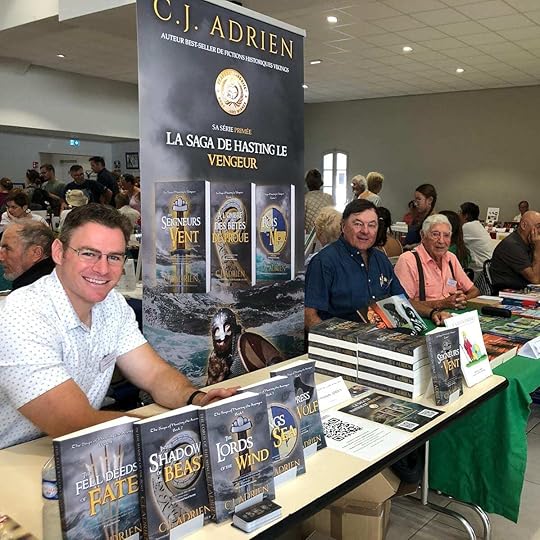 Three generations of authors at the same book fair, dubbed “Adrien’s Wall.”
Three generations of authors at the same book fair, dubbed “Adrien’s Wall.”The month of August looks to be one focused on settling down, finding our routine, and of course, writing! My editor approved the outline for book 6 in Hasting’s Saga, and I’m chomping at the bit to get into it. Until then, if you haven’t already (and thank you 🙏 to all who have), consider supporting my work by joining the longships on an epic Viking Age adventure with the most notorious Viking of them all.
I took the time to shoot a quick promo for my books on Instagram, titled “Ragnar didn’t do it.” Hasting did!”:
vikingwriter A post shared by @vikingwriter
A post shared by @vikingwriterI’ve joked about how part of my integration into French society means taking August off, but of course, I’m not actually going to do that. Starting next week, I’ll be back into the flow of things with a regular newsletter containing the Viking history, writing tips, and reading recommendations you’ve come to enjoy on Mondays. Until then, have a wonderful week!
~ C.J.
July 26, 2025
Le Lac de Grand Lieu: How Far the Vikings Went to Target Monasteries.
Welcome to the newsletter where history, storytelling, and inspiration meet. Every week, I share some of the fun historical research I’ve done while writing my novels, writing reflections (and sometimes tips), and sharing updates on my work and journey. If you were forwarded this message, you can join the weekly newsletter here.
Today’s DispatchViking History: Le Lac de Grand Lieu: How Far the Vikings Went to Target Monasteries.
Writing and Publishing: Getting to the keyboard is half the battle.
Author Update: Le Salon des Arts et du Livre de L’Epine.
Viking HistoryLe Lac de Grand Lieu: How Far the Vikings Went to Target Monasteries. A Statue of St. Philbert, the patron saint of the monastery of Saint Philbert, on the shores of the Lac de Grand Lieu.
A Statue of St. Philbert, the patron saint of the monastery of Saint Philbert, on the shores of the Lac de Grand Lieu.I’ve written extensively about the monks of the monastery of Saint Philbert on the island of Noirmoutier, and their seasonal migrations inland to escape the “ravages of the Northmen.” What I have not covered is what happened to them after they definitively abandoned the island in 836, following a failed attempt to defend their land holdings against the Vikings. One might be tempted to think that, since the Vikings got what they wanted, they would leave the monks alone. Not true. Even though the satellite priory they fled to was on the edge of France’s largest lake, Le Lac de Grand Lieu, and somewhat hidden in remote countryside, their struggles with Viking raids did not end on the island.
Le Lac de Grand Lieu covers an expansive twenty-four square miles and is located just a few miles south of the Loire River. What makes it unique is its shallowness. It’s only about six feet deep at its deepest point during summer, and slightly deeper during the rainy seasons of fall, winter, and spring. The priory of Saint Philbert is situated on the western shore of the lake, near the confluence of two tributaries of the Loire. Neither tributary is very wide—today, they are used exclusively by small barges, canoes, and kayaks, with no larger vessels. A thousand years ago, this would have also been the case. An ecclesiastical document mentions the difficulty of building in the area, as materials like stone had to be shipped overland from outside sources because the waterways were considered “unusable.”
The monks probably thought they were safe there. As far as they knew, they were in the middle of nowhere and beyond the reach or interest of the Vikings. Even as the Vikings increased their attacks in the area, with raids along the Loire—including the infamous sack of Nantes in 843—their remote location and hard-to-navigate tributaries likely made them feel safe, giving them a false sense of security.
I imagine the shock the monks must have felt upon seeing longships rowing up the shallow tributaries to the lake on the morning of March 29, 847. Nothing could have prepared them for it. And as had happened numerous times on the island of Noirmoutier, the monastery was robbed and burned. According to the sources, they had time to hide the bones of their patron saint in a hidden corner of the monastery, which saved them from losing their holy relics. To me, this suggests a slow-moving disaster in which the monks had been warned about one or two longships moving up the tributaries, giving them time to leave. After the attack, the monks moved again, this time further inland, to Tournus. The Vikings did not find them there (although marauding Hungarians did).
As I argue in my article on salt as a motivator for Viking raids, the repeated attacks on the island of Noirmoutier before 836 differed in type and frequency from the hit-and-run raids linked to the first phase of Viking expansion. I have used this point to suggest that there may have been more to those raids than just a simple desire to target a vulnerable area. Surely the monks would not have replenished the monastery’s wealth year after year, knowing the Vikings would come for it in the spring, I’ve argued. There must have been something else.
But this single raid in 847, targeting a monastery off the beaten path, says something different. 847 was a significant year for the region. A Viking army—which I call ‘The Great Heathen Army Before the Great Heathen Army’—fought and won three consecutive battles against the Bretons, fueling fears of invasion and occupation. The Frankish nobility was still reeling from the devastation at the Battle of Fontenoy-en-Puisaye, and so they were powerless to help. Raids along the Loire River numbered in the dozens, hitting targets both big and small, including fortified cities and much larger religious centers than Saint Philbert. The region was the Vikings’ oyster. So why did they go out of their way to pillage the monastery of Saint Philbert on the Lac de Grand Lieu?
The simplest answer is that monasteries were just too lucrative not to raid. To me, this suggests that they—the monks—might have been foolish enough to replenish their wealth on the island every year after the raiding season, after all. It contradicts my argument that Viking activity in the area was targeted, resource-driven, and connected to much larger long-term causes of the Viking Age. The idea still holds weight, but the fact that the Vikings later followed the monks inland after abandoning the island shows that the monastery held something of interest to them beyond salt.
It's possible that the raid was simply an accident. Given all the activity in the area, it’s plausible to think that a few ships broke away from the larger fleet and searched the countryside for what they could find. In such a case, we might attribute it to bad luck for the monks. It could also be that the economics of raiding had shifted, and the appeal of salt no longer motivated foreign expeditions. Whatever the situation, it seems clear that monasteries remained too valuable for the Vikings to ignore, even during the second phase of expansion, even if it meant a slight detour into the remote French countryside.
Writing and PublishingHalf the Battle is Just Getting ThereI credit much of the discipline I have in writing to the discipline I developed in my chosen sport of bodybuilding. Throughout my twenties and early thirties, I was a dedicated athlete with a calendar that revolved around my gym time. Unlike many of the best-looking athletes of my time, I was not blessed with a genetic advantage. I was a chubby kid with a disposition to be a chubby adult, and I’ve had to fight for every inch I’ve kept off my waist and kept on my chest. I had to work hard and stay organized, never letting up, because I couldn’t afford to let up. Some called it an obsession. I call it dedication.
Over the years, friends and family have looked to me for advice on improving their fitness. My number one saying has always been: “Half the battle is getting to the gym.” I don’t know where I heard it, but it stuck with me my entire adult life. It’s so easy to miss a session. Life gets in the way.
I understand that excuse. I have kids, work, chores, errands, and a packed schedule; things don’t always go as planned. But I never cut out of the gym. I know that as soon as I do that, it won’t just be the gym. It’ll be everything else that matters. Permitting yourself to miss a session enables you to keep unraveling. And that’s where writers need to beware.
When I started writing novels, I was not disciplined. It was a dream to write a book, yes, but a hobby nonetheless. It was something that I could miss if time ran short. But then one day, when I realized I had made no progress in a year, I asked myself, “What if I treat writing time like my gym time?”
Next thing I knew, my calendar had two immovable time blocks: gym and writing. And that’s how it’s been ever since. It’s allowed me to stay productive in writing despite day jobs, family, and life. Carving out that time and forcing myself to the computer to write always yields something. I’m not always motivated or inspired, but I always get something out, even if it’s not good. Today I’ve penned close to ten books before the age of forty, all while juggling the rigors of the busy modern life.
I suppose what I’m trying to say in all this is **in Arnold voice** “GET TO THA WRITING DESK!!”
Author UpdateSalon des Arts et du Livre de L’Epine
Next week, I will be a featured author at the Salon des Arts et du Livre de L’Epine. L’Épine is a village on the island of Noirmoutier, which is one of the settings of my series, The Saga of Hasting the Avenger. I’ll be selling copies of The Lords of the Wind in French and signing books.
And, as always…Buy my novels!
July 14, 2025
Were Vikings literally larger than life?
Welcome to the newsletter where history, storytelling, and inspiration meet. Every week, I share some of the fun historical research I’ve done while writing my novels, writing reflections (and sometimes tips), and sharing updates on my work and journey. If you were forwarded this message, you can join the weekly newsletter here.
Today’s DispatchViking History: Were Vikings literally larger than life?
Writing and Publishing: Outline Smarter, Not Harder.
Author Update: New Course on Chivalry through Medievalists.net.
This week’s book recommendation.
Viking HistoryWere the Vikings Literally Larger than Life?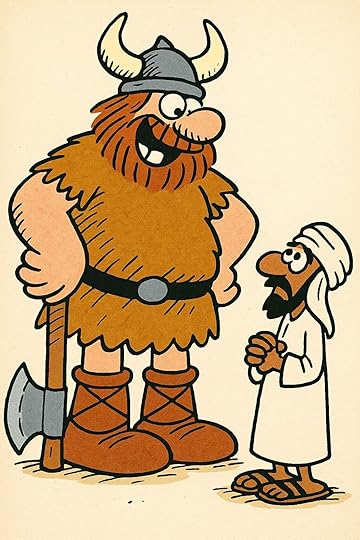 A humorous take on the Ibn Fadlan account.
A humorous take on the Ibn Fadlan account.One of the best parts of writing about Viking history is when thoughtful readers and fellow writers jump into the fray with their perspectives. This week, I came across a fantastic essay by Richard at The Northvegr Journal titled “Vikings Weren’t Average — And Neither Were Their Axes.” In it, he explores the longstanding perception that Viking raiders were physically exceptional—taller, stronger, and more intimidating than their contemporaries—and makes the case that those who went raiding likely were elite warriors whose physical prowess stood out, both in their time and in cultural memory.
Richard and I are actually in broad agreement on a few key points: most archaeological evidence points to an average male height of around 5’7” to 5’9” for Viking Age Scandinavians—roughly in line with other Europeans of the era. Where we diverge is in the interpretation of what that means. In my article on Viking height (written over ten years ago now), I took a more skeptical view of written sources and emphasized the limits of the archaeological data. Richard leans into the symbolic power of memory and myth, arguing that the warriors who sailed abroad may have been exceptional, even if the average Viking Age Scandinavian at home was not.
It’s a great example of what I love about this kind of work: we can examine the same sources and come away with different takes, and have a respectful, intellectually stimulating conversation along the way.
Read Richard’s in-depth article below and subscribe to his Substack if you’re into Viking history:
 Northvegr’s SubstackVikings Weren’t Average — And Neither Were Their AxesPicture this: a monk, breath caught in his throat, watching from behind a cloister wall as longships pull ashore. The men who leap out aren’t cloaked shadows — they’re bright-haired, broad-shouldered, and terrifyingly real. Not giants, but not average. And each carries an axe like it was born with him…Read morea day ago · 1 like · The Northvegr JournalWriting and PublishingOutline Smarter, Not Harder
Northvegr’s SubstackVikings Weren’t Average — And Neither Were Their AxesPicture this: a monk, breath caught in his throat, watching from behind a cloister wall as longships pull ashore. The men who leap out aren’t cloaked shadows — they’re bright-haired, broad-shouldered, and terrifyingly real. Not giants, but not average. And each carries an axe like it was born with him…Read morea day ago · 1 like · The Northvegr JournalWriting and PublishingOutline Smarter, Not HarderWhether you're a plotter, pantser, or somewhere in between, there's no escaping this truth: if your novel lacks structure, your reader will feel it—even if they can’t put their finger on why. One of the best tools I’ve used to clarify story structure is a worksheet I received from my editor that poses a specific set of questions every novelist should be able to answer.
Before you even start drafting—or especially before revisions—it helps to sit down and ask yourself:
What does my protagonist want, and what need is in conflict with that want?
What does their normal life look like before everything changes?
What single moment shatters that normal life and forces them into action?
What choice do they make early on that commits them to a path they can’t walk back from?
What twist hits them halfway through that changes the entire trajectory of the story?
Do they hit a low point near the end, and if so, what or who helps them rise again?
What truth have they learned by the final confrontation?
This isn’t just about “three acts” or “beats.” It’s about understanding narrative momentum: what drives the character forward and what forces them to grow. If you can't identify these elements, your story may not be fully formed yet—and that’s okay. Use the above questions to guide your narrative choices, and if you’d like to bounce ideas off of me or for me to send you the worksheet, shoot me an email.
Even discovery writers benefit from this kind of reflection, especially after the first draft. Great stories don’t just happen. They’re built.
Author UpdateNew Course: The Inception, Evolution, and Legacy of Chivalry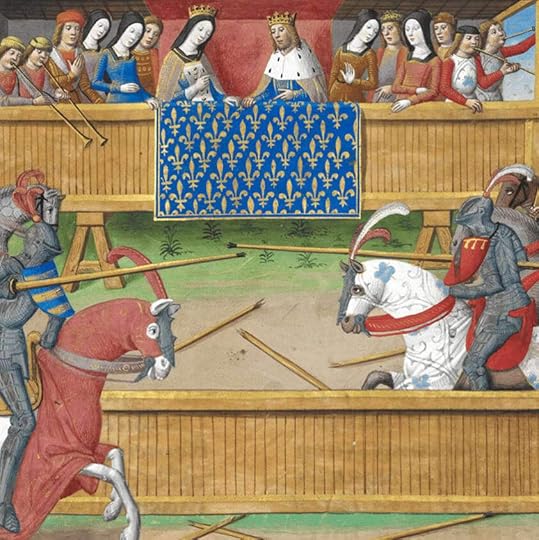
This week, I was invited to teach a course on Chivalry at Medievalists.net. Explore the origins, cultural evolution, and decline of Chivalry in medieval Europe by examining its historical context, legal codification, literary expression, and lasting legacy from the early warrior class to national militaries and modern ideals. The first session will be on September 16, and the course will run for 6 weeks. I can’t wait to share my other passion that often gets eclipsed by the Vikings: chivalry!
Book RecommendationsEmbers of the Hands by Eleanor Barraclough.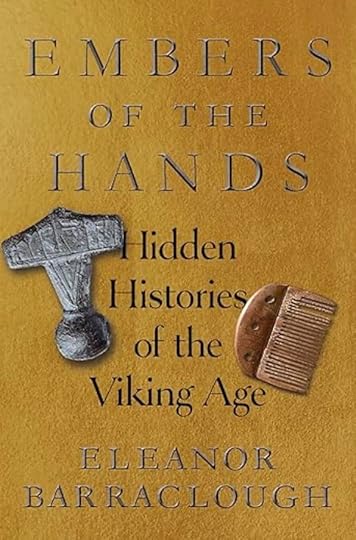
Blurb:
In imagining a Viking, a certain image springs to mind: a barbaric warrior, leaping ashore from a longboat, and ready to terrorize the hapless local population of a northern European town. Yet while such characters define our imagination of the Viking Age today, they were in the minority.
Instead, in the time-stopping soils, water, and ice of the North, Eleanor Barraclough excavates a preserved lost world, one that reimagines a misunderstood society. By examining artifacts of the past―remnants of wooden gaming boards, elegant antler combs, doodles by imaginative children and bored teenagers, and runes that reveal hidden loves, furious curses, and drunken spouses summoned home from the pub―Barraclough illuminates life in the medieval Nordic world as not just a world of rampaging warriors, but as full of globally networked people with recognizable concerns.
This is the history of all the people―children, enslaved people, seers, artisans, travelers, writers―who inhabited the medieval Nordic world. Encompassing not just Norway, Denmark, and Sweden, but also Iceland, Greenland, the British Isles, Continental Europe, and Russia, this is a history of a Viking Age filled with real people of different ages, genders, and ethnicities, as told through the traces that they left behind.
“Embers of the hands” is a poetic kenning from the Viking Age that referred to gold. But no less precious are the embers that Barraclough blows back to life in this book―those of ordinary lives long past.
And, as always…Buy my novels!
July 7, 2025
Stop Correcting People About ‘Viking’
Welcome to the newsletter, where history, storytelling, and inspiration meet. Every week, I share some of the fun historical research I’ve done while writing my novels, writing reflections (and sometimes tips), and sharing updates on my work and journey. If you were forwarded this message, you can join the weekly newsletter here.
Today’s DispatchViking History: Revisting the word ‘Viking.’
Writing and Publishing: Whoopsie! I made a mistake.
Author Update: The Empress and Her Wolf is Available Now!
This week’s book recommendation.
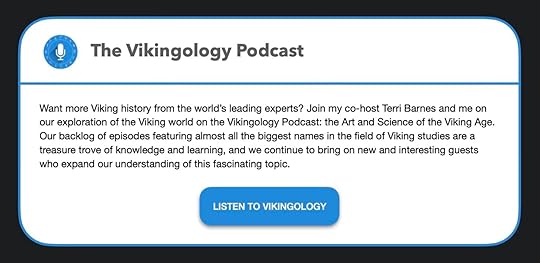 Viking HistoryWhy You Should Think Twice Before Correcting Others on Their Use of the Word ‘Viking.’
Viking HistoryWhy You Should Think Twice Before Correcting Others on Their Use of the Word ‘Viking.’
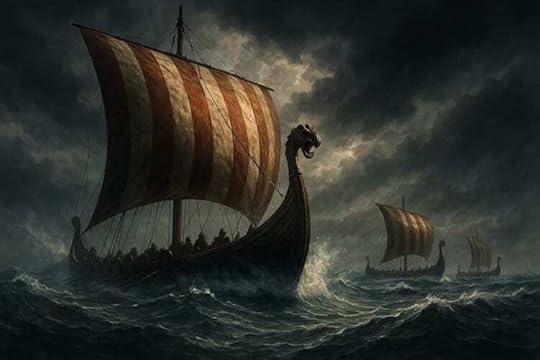
In the world of online discourse about the Viking Age, few topics attract as much controversy as the definition of the word Viking. Every day, I come across posts featuring a deluge of comments from people rushing in to correct others on how they’ve used the word. Most often, these corrections take the form of a now-common refrain: “Viking was a job, not a people.”
I’m not sure where this trend began, but it’s gotten out of hand. The certainty with which it’s repeated belies the actual complexity of the issue. Not only is the “Viking as a job” claim overly simplistic, but it’s incorrect. I say this not as someone new to this conversation, but as someone who has researched, written about, and taught on the subject for years.
In my article "Do You Use the Word Viking Correctly?", I explored this issue in depth and came to a simple conclusion: so long as you define how you intend to use the word, you’re using it correctly.
Let me explain why that matters.
There is no consensus on the origin of the word Viking. Nor is there agreement on its meaning. Even among experts, debates continue over how it was used during the Viking Age, and how it made its way into the English language. That’s not just my opinion. It’s the reality faced by anyone who dives into the scholarship.
Recently, I shared a public service announcement in response to the wave of online corrections:
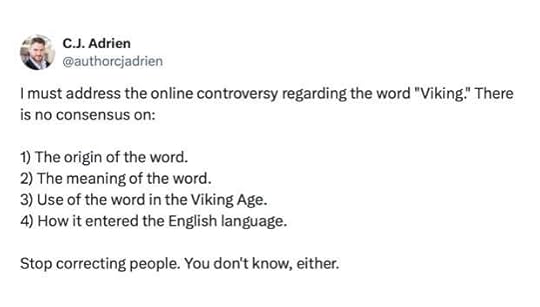
The tweet received some great responses, including one from renowned Viking Age scholar Judith Jesch. She offered a welcome refinement:
“I would rather say that it is not a matter of ‘consensus’, rather one of multiple origins, multiple meanings (over time and different languages), multiple uses in the Viking Age, and multiple entries into the English language. You could even say, multiple words.”
Her words capture the issue perfectly. Viking is a word with layers. It doesn’t belong to a single definition or etymology. It evolved over centuries, crossing linguistic and cultural boundaries, and took on different meanings depending on the time and place.
That brings us back to the most important point: unless you're engaging in a scholarly debate within a very specific context, what's far more useful than correcting someone’s use of the word is asking what they mean by it. If they define it clearly—whether they use it to mean a seaborne raider, a Scandinavian explorer, or even a broader cultural identity—then that definition should frame how the word is interpreted.
Ultimately, Viking is a complex, nuanced, and still somewhat enigmatic term. And that’s okay. Words often carry many layers of history. But using that complexity as a blunt instrument to shame or “correct” others is counterproductive. Instead, I encourage everyone passionate about the Viking Age to adopt a little humility. Dig deeper. Ask questions. And remember: if someone is using the word Viking with a clear definition in mind, they’re using it correctly.
Let’s foster better conversations, not pedantic ones.
Writing and PublishingWhoopsie! I Made a Mistake…A sharp-eyed reader (thank you, Emma!) pointed out a name inconsistency between The Fell Deeds of Fate and The Empress and Her Wolf. Specifically, a character named Theresa in the former appears as Eyvor in the latter, with no explanation.
Here’s what happened: during the many rewrites of The Empress and Her Wolf, a key line was accidentally cut in the back-and-forth with editors and proofreaders. That line was meant to clarify the name change:
“In court, she went by the Christian name Theresa, but among our kin, she preferred we call her by her birth name, Eyvor.”
The detail was intentional. I wanted to reflect the dual identity of a Rus courtier who had assimilated into Byzantine culture, yet—when confronted with her kin—reverted to the name of her heritage. It was a subtle nuance, intended to reflect the emotional and cultural complexities of emigration and identity. Unfortunately, it didn’t make it into the final cut.
The good news is: the line has now been restored in the current version of the novel.
However, if you pre-ordered or purchased The Empress and Her Wolf on release day, your copy won’t include it. I’m truly sorry for the oversight. Please know that Eyvor and Theresa are the same person, and the change was deliberate from the start. In all my outlines and planning notes, she’s always been Eyvor.
Thank you again to everyone reading, and especially to those who take the time to point out things that slip through the cracks. Your support means the world 🙏
BUY THE EMPRESS AND HER WOLF !!
Author UpdateThe Empress and Her Wolf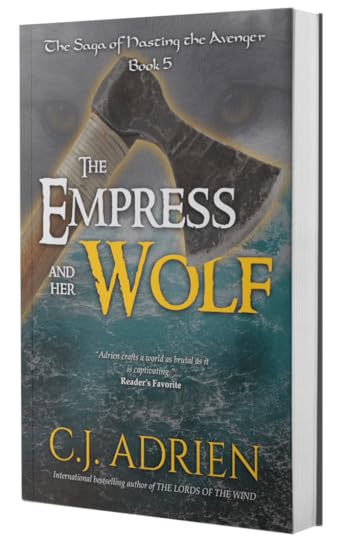
The Empress and Her Wolf, book 5 of the Hasting Saga, hits shelves TOMORROW. Here’s the blurb:
Power. Revenge. Forbidden love in the heart of a dying empire.
When Viking warlord Hasting arrives at the gates of Constantinople, he knows he can’t conquer it. Not with deeds of arms alone. But fate has other plans.
A failed raid turns into a devil’s bargain: serve Empress Theodora as her sword-for-hire, or die. Hasting chooses survival and quickly proves himself more capable than the generals she no longer trusts. But the empire is a viper’s nest of betrayal, and when an attempt to scare off his men ends in the death of his lover, Hasting’s mission changes.
He came for wealth and glory. Now, he wants blood.
But revenge in Miklagard is no simple feat. The city runs on whispers, not war cries. Enemies hide behind silks and smiles. And as Hasting grows closer to the empress—ally, ruler, and eventually lover—he finds himself torn between love and vengeance.
One wrong move could cost him everything.
Perfect for fans of Bernard Cornwell, Giles Kristian, Peter Gibbons, and Conn Iggulden, The Empress and Her Wolf is a heart-pounding saga of war, loyalty, and ambition set against the glittering, dangerous world of the Byzantine Empire.

Judith Jesch, one of the foremost scholars of the Viking Age, has a new book available for pre-order: The Sagas of the Earls of Orkney, set to release in January.
We recently had the pleasure of hosting Professor Jesch on the Vikingology podcast, where she shared insights from her ongoing research into the rich literary and historical traditions surrounding the Orkney earls. Her deep knowledge and fresh perspective made for a fascinating conversation—and if that’s any indication, this new book will be a must-read for anyone interested in saga literature, Norse culture, and the complexity of power on the northern fringes of the Viking world.
Whether you’re a casual fan or a serious student of the era, this upcoming release promises to offer a compelling look into one of the most enduring and enigmatic branches of the Norse legacy.
Check out the episode on Vikingology:
 Vikingology Podcast The Saga of the Earls of Orkney and Skaldic PoetryIn this episode we traverse a lot of Viking ground. Dr. Jesch is a scholar who has written on several aspects of the Viking Age over a long and distinguished career, from women and the Nordic diaspora to poetry and the runes. We talk to her about the influence Vikings had on the various areas where they traveled and settled, the difference between Skald… Listen now2 years ago · Vikingology Podcast and C.J. Adrien
Vikingology Podcast The Saga of the Earls of Orkney and Skaldic PoetryIn this episode we traverse a lot of Viking ground. Dr. Jesch is a scholar who has written on several aspects of the Viking Age over a long and distinguished career, from women and the Nordic diaspora to poetry and the runes. We talk to her about the influence Vikings had on the various areas where they traveled and settled, the difference between Skald… Listen now2 years ago · Vikingology Podcast and C.J. AdrienBlurb:
This fascinating history of the Earldom of Orkney, which was established in the Viking Age, records the adventures, feuds and battles of powerful Norsemen during its first three centuries. The medieval earls of Orkney owed allegiance to the kings of Norway but their influence ranged from Britain and Ireland to Sweden and Russia, and they travelled as far as Narbonne, Crete and Jerusalem. Advised by bishops and formidable women, they and their henchmen jockeyed for power with each other and with neighbouring rulers in Scotland, often with murderous outcomes. In between the high politics and violence, the world of the earls was one of piety, poetry and feasting.
The Saga also provides rare glimpses of culture and everyday life in northern Scotland when it was central to the Viking diaspora. Set in a recognisable landscape, it mentions features, sites and even buildings that can still be seen today.
This new translation of the manuscripts of the Saga uses an innovative approach to presenting medieval sources to non-specialist audiences, highlighting textual variations that affect its interpretation. It also reflects saga style and language more closely than previous translations and is ideal for both research and reading aloud. This is an essential, detailed and up-to-date resource for academics and general readers who wish to know more about Viking and Norse Scotland.

July 3, 2025
The Saga of Hasting the Avenger
 One man. One destiny. Reputation is Everything.
One man. One destiny. Reputation is Everything.Award-Winning and Critically AcclaimedFrom slave to warlord, from the misty shores of Brittany to the glittering palaces of Constantinople, Hasting carves his legend in blood and fire. The Saga of Hasting the Avenger is a sweeping, character-driven Viking epic that blends gritty realism, political intrigue, and unforgettable battles with the soul of a man torn between kin and glory.
Winner of the 2020 Reader’s Favorite Award.
“Richly developed fictional adventures of a real Viking on an epic journey through Europe. Our verdict: Get it!” - Kirkus Reviews
“If you want to sit down with an extremely well-researched tale involving heroic battles, first loves, and the making of a legend, this book is for you…A must-read for those who enjoy Viking stories.” - The Historical Novel Society
“A masterful blend of historical fiction and mythological undertones. Adrien crafts a world as brutal as it is captivating. A must-read for fans of Viking tales and epic sagas.” - Reader's Favorite
“The prose is delectable, and the overall writing is cinematic.” - The Book Commentary
“A page-turning event.” - Hoover Book Reviews
Sail with the most notorious Viking of them all!With five books and counting, the series follows the real historical Viking Hasting from his youth in captivity to his rise as one of the most feared warlords of the 9th century. You’ll sail with him through betrayal, battle, and diplomacy—from the salt marshes of Noirmoutier to the siege towers of Anatolia. If you love historical fiction that doesn’t just recreate the past but pulls you into it, this is your next binge-worthy obsession. Rich in detail, fast-paced, and emotionally resonant, this saga is not just about war, but the cost of becoming a legend.
Perfect for fans of Bernard Cornwell, Giles Kristian, Peter Gibbons, and Conn Iggulden, The Saga of Hasting the Avenger is a heart-pounding Viking epic of war, loyalty, and ambition, spanning from the storm-lashed coasts of Francia to the opulent, treacherous courts of the Byzantine Empire.
The Latest Release: The Empress and Her Wolf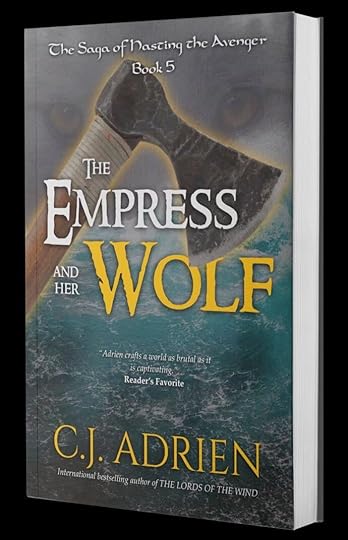
Power. Revenge. Forbidden love in the heart of a dying empire.
When Viking warlord Hasting arrives at the gates of Constantinople, he knows he can’t conquer it. Not with deeds of arms alone. But fate has other plans.
His failed raid turns into an opportunity: serve Empress Theodora as her sword-for-hire. Hasting quickly proves himself more capable than the generals she no longer trusts. But the empire is a viper’s nest of betrayal, and when an attempt to scare off his men ends in the death of his lover, Hasting’s mission changes.
He came for wealth and glory. Now, he wants blood.
But revenge in Miklagard is no simple feat. The city runs on whispers, not war cries. Enemies hide behind silks and smiles. And as Hasting grows closer to the empress—ally, ruler, and eventually lover—he finds himself torn between love and vengeance.
One wrong move could cost him everything.
To everyone who has sailed with Hasting from the beginning: THANK YOU 🙏. What began as a passion project rooted in my love of storytelling and Viking history has grown into something far greater, and that’s because of you. Your support, your messages, your reviews, and your word-of-mouth have brought The Saga of Hasting the Avenger to life in ways I never imagined.
If you’ve enjoyed the journey, the best way to help is simple:
👉 Leave a review on Amazon or Goodreads
👉 Tell a friend who loves historical fiction
👉 Or just share the books on social media — every post makes a difference.
Your enthusiasm is what fuels this saga. More adventures are on the horizon, and I can’t wait to share what comes next.
With gratitude,
C.J. Adrien
Reputation is everything.
July 1, 2025
Live with C.J. Adrien
 Get more from C.J. Adrien in the Substack appAvailable for iOS and AndroidGet the app
Get more from C.J. Adrien in the Substack appAvailable for iOS and AndroidGet the app



